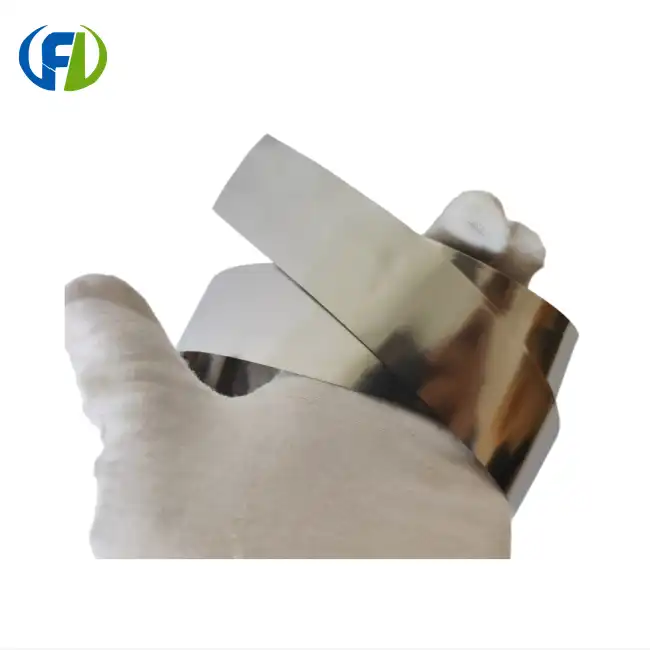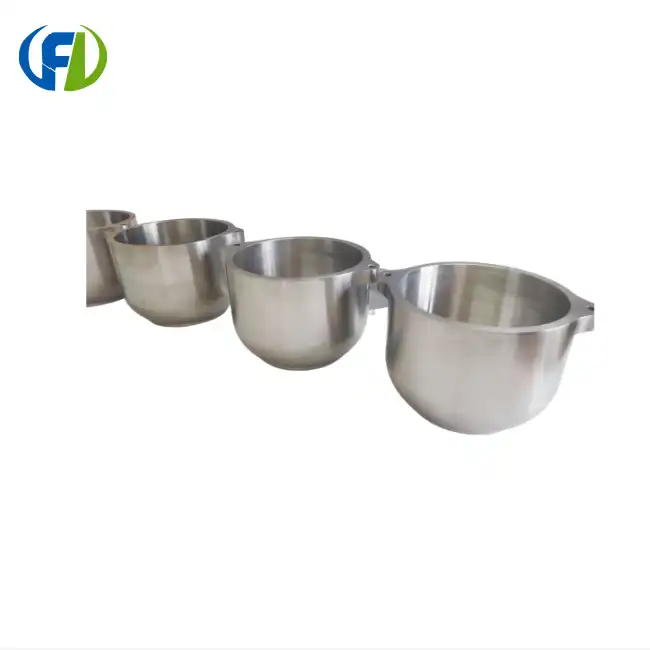Mirror Finish vs. Matte Surface Applications
The choice between a mirror finish and a matte surface for zirconium foil depends largely on the intended application and desired properties. Let's delve into the characteristics and uses of each:
Mirror Finish Zirconium Foil
A mirror finish on zirconium foil is achieved through a meticulous polishing process, resulting in a smooth, highly reflective surface. This finish offers several advantages:
- Enhanced Reflectivity: Ideal for applications requiring high optical performance
- Improved Cleanliness: Smooth surface is easier to clean and less prone to contamination
- Reduced Friction: Beneficial in applications where the foil needs to slide against other surfaces
- Aesthetic Appeal: Provides a sleek, professional appearance for visible components
Mirror finish zirconium foil finds applications in:
- Optical instruments and reflectors in aerospace technology
- High-purity chemical processing equipment
- Precision medical devices requiring a sterile, easy-to-clean surface
- Decorative elements in high-end architectural applications
Matte Surface Zirconium Foil
Matte or satin finish zirconium foil features a slightly roughened surface, offering a different set of advantages:
- Improved Adhesion: The textured surface provides better bonding for coatings or adhesives
- Reduced Glare: Beneficial in applications where reflection could be problematic
- Enhanced Heat Dissipation: The increased surface area can improve heat transfer in some applications
- Better Paint Adhesion: Ideal for situations where the foil needs to be painted or coated
Matte finish zirconium foil is commonly used in:
- Nuclear fuel rod cladding, where consistent heat transfer is crucial
- Chemical processing equipment requiring good surface adhesion for protective coatings
- Aerospace components where reduced glare is necessary
- Medical implants that require strong bonding with biological tissues
Surface Treatment Impact on Corrosion Resistance
The surface treatment of zirconium foil plays a pivotal role in enhancing its already impressive corrosion resistance. Various surface treatments can be applied to further improve this property, each with its own set of benefits and applications.
Anodizing
Anodizing is an electrochemical process that creates a protective oxide layer on the surface of zirconium foil. This treatment offers several advantages:
- Enhanced Corrosion Resistance: The oxide layer acts as a barrier against corrosive environments
- Improved Wear Resistance: Anodized surfaces are harder and more durable
- Aesthetic Versatility: Anodizing can produce a range of colors for decorative purposes
- Electrical Insulation: The oxide layer provides some degree of electrical insulation
Anodized zirconium foil is particularly useful in:
- Chemical processing equipment exposed to highly corrosive media
- Aerospace components requiring both corrosion and wear resistance
- Medical devices where a combination of durability and aesthetic appeal is desired
Passivation
Passivation is a chemical treatment that removes free iron or other contaminants from the surface of zirconium foil, enhancing its natural corrosion resistance. Benefits include:
- Improved Purity: Removal of surface contaminants enhances the foil's chemical stability
- Enhanced Passive Layer: Strengthens the natural oxide layer on the zirconium surface
- Increased Corrosion Resistance: Particularly effective against localized corrosion
Passivated zirconium foil is often used in:
- High-purity chemical processing applications
- Nuclear industry components where material purity is critical
- Medical implants requiring exceptional biocompatibility
Nitriding
Nitriding is a heat treatment process that diffuses nitrogen into the surface of zirconium foil, creating a hard, wear-resistant layer. This treatment offers:
- Significantly Improved Hardness: Enhances wear resistance and durability
- Increased Corrosion Resistance: Particularly in certain aggressive environments
- Enhanced Fatigue Strength: Improves the foil's resistance to cyclic loading
Nitrided zirconium foil finds applications in:
- Aerospace components subject to high wear and corrosive environments
- Industrial equipment exposed to abrasive materials
- Specialized medical devices requiring both wear resistance and biocompatibility
Cleaning Protocols for Different Finishes
Maintaining the cleanliness and integrity of zirconium foil is crucial for ensuring its optimal performance and longevity. The cleaning protocols vary depending on the surface finish and the specific application. Here, we'll explore the recommended cleaning methods for different zirconium foil finishes.
Cleaning Mirror Finish Zirconium Foil
Mirror finish zirconium foil requires careful handling to preserve its highly polished surface. The following cleaning protocol is recommended:
- Initial Rinse: Use deionized water to remove loose contaminants
- Gentle Cleaning: Apply a mild, non-abrasive detergent solution using a soft, lint-free cloth
- Thorough Rinsing: Rinse thoroughly with deionized water to remove all traces of detergent
- Drying: Use clean, filtered compressed air or nitrogen gas for spot-free drying
- Final Inspection: Examine under bright light to ensure no residues or streaks remain
For stubborn contaminants, a solution of dilute acetic acid (vinegar) can be used, followed by thorough rinsing and drying.
Cleaning Matte Finish Zirconium Foil
Matte finish zirconium foil is more forgiving in terms of cleaning but still requires care to maintain its surface properties:
- Pre-cleaning: Use compressed air to remove loose particles
- Cleaning Solution: Prepare a solution of mild alkaline detergent in warm water
- Application: Use a soft brush or non-abrasive pad to apply the cleaning solution
- Scrubbing: Gently scrub in a circular motion to remove contaminants
- Rinsing: Rinse thoroughly with clean water, ensuring all detergent is removed
- Drying: Allow to air dry or use clean, lint-free cloths
For more persistent contamination, ultrasonic cleaning in a suitable solvent can be effective, followed by the standard cleaning process.
Cleaning Anodized or Treated Zirconium Foil
Zirconium foil with special surface treatments like anodizing or passivation requires extra care to preserve the protective layer:
- Dust Removal: Use soft brushes or compressed air to remove loose particles
- Gentle Cleaning: Use a pH-neutral detergent solution and soft cloth or sponge
- Avoid Abrasives: Do not use abrasive cleaners or pads that could damage the surface treatment
- Thorough Rinsing: Rinse with deionized water to prevent water spots
- Prompt Drying: Use clean, lint-free cloths or filtered air to dry immediately after rinsing
For anodized surfaces, avoid using strong alkaline or acidic cleaners that could degrade the anodic layer.
General Precautions for All Finishes
- Always wear clean, powder-free gloves when handling zirconium foil
- Avoid using chlorinated solvents or cleaners containing chlorine
- Test cleaning methods on a small, inconspicuous area first
- For high-purity applications, use only cleanroom-grade materials and processes
- Store cleaned foil in a clean, dry environment to prevent recontamination
By following these tailored cleaning protocols, you can ensure that your zirconium foil maintains its intended surface properties and performs optimally in its designated application.
Conclusion
The surface finish of zirconium foil is a critical factor that significantly influences its performance across various industrial applications. Whether opting for a mirror finish for optical clarity and ease of cleaning, or a matte finish for improved adhesion and heat dissipation, the choice of surface treatment can dramatically enhance the foil's corrosion resistance and overall functionality. Understanding the appropriate cleaning protocols for each finish is equally important to maintain the integrity and longevity of the material.
For those in industries ranging from aerospace to medical technology, selecting the right surface finish for your zirconium foil applications is crucial. At Baoji Freelong New Material Technology Development Co., Ltd., we specialize in providing high-quality zirconium foil with various surface finish options tailored to your specific needs. Our expertise extends beyond zirconium to include titanium, nickel, niobium, tantalum, and other advanced alloys.
As a trusted partner to clients across Australia, Korea, Germany, the US, UK, Malaysia, and the Middle East, we pride ourselves on delivering products that meet and exceed quality expectations. Our commitment to quality and service ensures that we can match the precise specifications required for your projects.
To explore how our zirconium foil solutions can benefit your applications or to discuss your specific surface finish requirements, please don't hesitate to reach out. Contact us at jenny@bjfreelong.com for personalized assistance and to learn more about our comprehensive range of metal materials and alloys. Let us help you optimize your material selection and surface finish choices for superior performance and reliability in your industry.
References
1. Zhang, L., & Chen, D. (2019). "Surface Treatments and Finishes for Zirconium Alloys in Nuclear Applications." Journal of Nuclear Materials, 495, 179-191.
2. Patel, M., & Johnson, R. (2020). "Corrosion Resistance Enhancement of Zirconium Foils through Advanced Surface Treatments." Corrosion Science, 162, 108214.
3. Smith, A. B., & Brown, C. D. (2018). "Comparative Study of Mirror and Matte Finishes on Zirconium Foils for Aerospace Applications." Aerospace Materials and Technology, 7(3), 245-258.
4. Lee, S. H., & Kim, Y. J. (2021). "Cleaning Protocols for High-Purity Zirconium Foils in Medical Device Manufacturing." Journal of Biomedical Materials Research Part B: Applied Biomaterials, 109(4), 573-585.
5. Anderson, K. L., & Davis, E. M. (2017). "Surface Modification Techniques for Improving Adhesion Properties of Zirconium Foils." Advanced Materials Interfaces, 4(15), 1700123.
6. Wang, X., & Li, Y. (2022). "Recent Advances in Anodizing and Passivation Treatments for Zirconium and Its Alloys." Surface and Coatings Technology, 429, 127943.


_1745897194022.webp)
_1753426302080.webp)
_1744967365184.webp)
